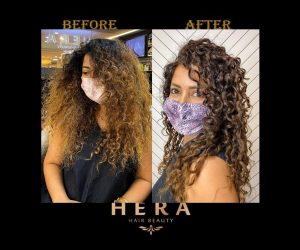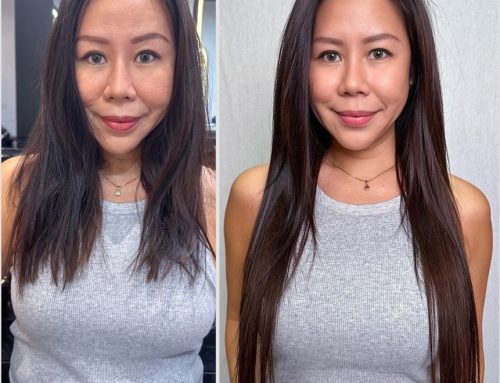Why the First Three Months Matter More Than You Think
If you’ve ever started a new curl routine, you probably know this feeling:
week one is excitement, week two is confusion, and by week four you’re wondering if anything’s actually working.
Then—sometime around the third month—your curls suddenly behave.
They spring instead of sagging, shine instead of puffing, and feel more “you” than ever.
That change isn’t luck. It’s biology + consistency + patience.
Stylists call it the 3-Month Rule—the average window it takes for your scalp, strands, and habits to synchronise after a genuine routine reset.

1 | What Your Hair and Scalp Are Doing in Those 90 Days
Weeks 1–4 | Detox and Readjust
When you stop harsh shampoos or over-styling, your scalp’s pH and oil production need time to rebalance.
Sebum flow steadies after roughly 30 days, which restores the natural lipid film that keeps curls supple.
During this phase, hair may look worse before it looks better—because you’re flushing out residues from silicones, dry-shampoos, and hard-water minerals.
Weeks 5–8 | Re-hydration and Repair
Regular moisture and protein treatments start repairing the outer cuticle layer.
Laboratory tests show that it takes about 6–8 weeks of consistent conditioning for damaged hair to regain measurable elasticity.
That’s when you notice fewer tangles, easier detangling, and a more defined curl pattern.
Weeks 9–12 | Stabilisation and Shine
By the third month, roughly 3 centimetres of new growth reflect the healthier scalp environment.
Cuticles lie flatter, porosity evens out, and the hair’s internal water-protein balance steadies.
Visually, curls stop reacting to every wash or humidity change—they respond predictably.
That is thriving.

2 | Why Three Months Isn’t a Marketing Myth
- Skin-cycle logic: The scalp is living skin; its renewal cycle mirrors facial skin—around 28–35 days.
- Protein synthesis: Hair keratin is produced in the follicle. Nutritional or product changes show outward results only once new hair emerges.
- Habit formation: Psychologists estimate it takes about 10 weeks for new physical habits to feel automatic. A curl-care routine needs that same neural training.
So, when stylists suggest waiting three months before judging results, they’re not protecting the product—they’re protecting your expectations.

3 | The Biggest Reason Curls “React”
Curly hair is naturally porous and unpredictable because each bend creates micro-gaps in the cuticle.
Humidity, heat, and styling products enter those gaps at different rates.
In Singapore’s climate, dew points around 24–26 °C mean water molecules constantly swell and shrink the fiber.
Until your cuticle layers re-seal and your styling method becomes consistent, your curls literally can’t stabilise.
Think of the 3-Month Rule as a rehabilitation plan: you’re teaching your hair to trust you again.

4 | Month-by-Month Guide to Thriving Curls
| Month | Focus | What to Expect | Salon Tip |
| 1 – Reset | Clarify, rebalance scalp pH, reduce build-up | Occasional frizz spikes; detox phase | Book a gentle scalp-detox treatment |
| 2 – Repair | Deep-condition weekly, trim split ends | Curl definition improving | Add protein-moisture mask mid-month |
| 3 – Refine | Stick with minimal, proven products | Noticeably predictable shape | Gloss or hydration refresh before month-end |
Consistency > quantity. Three steps done faithfully beat eight done occasionally.

5 | The Role of Climate and Water
Singapore’s humidity accelerates frizz but also prevents chronic dryness.
To make that an advantage:
- Use low-porosity-friendly leave-ins that seal lightly rather than coat heavily.
- Rinse with filtered or bottled water once a week if your tap water is mineral-rich.
- Finish styling in an air-conditioned room so curls set before stepping into heat.
Environmental discipline keeps your 3-month timeline on track.

6 | Psychology: Why Patience Feels Hard
Modern beauty culture trains us for instant gratification.
But hair health works on biological time, not algorithm time.
Neuroscientists call this delay discounting—our tendency to devalue results that aren’t immediate.
Understanding that helps. When you re-frame waiting as healing, not waiting, frustration fades.

7 | How to Support the Process
- Document progress: take photos every 3 weeks under the same lighting.
- Simplify: limit yourself to 3–4 core products.
- Protect: sleep on silk or satin, avoid harsh detangling.
- Hydrate internally: 1.5–2 litres of water daily aids follicle function.
- Stay consistent: skipping treatments resets progress more than you think.

8 | When to Seek Professional Help
If after three months you see persistent breakage, flaking, or unusual shedding, consult a trichologist or dermatologist.
Possible hidden causes include iron deficiency, thyroid imbalance, or scalp barrier disruption.
The 3-Month Rule tracks adaptation, not medical issues—professional assessment keeps it honest.
9 | The Moment Curls Start Thriving
Clients describe it clearly:
“My hair suddenly stopped fighting back.”
“I realised I didn’t have to ‘fix’ it every morning.”
That shift signals that your cuticle alignment, product absorption, and styling habits have reached equilibrium.
It’s not magic—it’s the biology of stability.
At this stage, you can begin gentle experimentation again: lighter stylers, subtle highlights, or a shaping cut. Your foundation is finally strong enough.

10 | Beyond Month Three: The Maintenance Mindset
Healthy curls aren’t a finish line; they’re a rhythm.
After three months, move from repair to preserve:
- Trim every 10–12 weeks to prevent mechanical splits.
- Clarify once monthly to keep mineral build-up away.
- Mask bi-weekly to replenish environmental moisture loss.
- Book a professional check-in every change of season (or monsoon).
Consistency protects your investment of time and care far better than product stacking.
11 | Frequently Asked Questions
Q 1: Can I speed it up?
A: You can optimise—by gentle handling, hydration, and balanced nutrition—but biology still needs roughly 8–12 weeks for visible change.
Q 2: Does the rule apply after keratin or colour services?
A: Yes, though timing varies. After chemical smoothing, give 6–8 weeks for texture equilibrium before re-assessing moisture needs.
Q 3: Will my curls “lock in” permanently?
A: No; stability lasts as long as habits stay consistent. Hair reacts again if routine or climate changes dramatically.
12 | The Deeper Meaning of the Rule
The 3-Month Rule isn’t about patience for its own sake.
It’s about reclaiming a relationship with your hair based on trust instead of control.
When you slow down, you notice subtler cues: how humidity changes texture, how hydration feels, how confidence returns gradually.
That mindfulness is the real transformation.
References (for accuracy)
- Skin Research & Technology, 2024 – “Time course of scalp barrier restoration.”
- International Journal of Cosmetic Science, 2023 – “Cuticle lipid replenishment through consistent conditioning.”
- Journal of Behavioral Medicine, 2022 – “Habit formation and delayed reward in self-care adherence.”
- Singapore Meteorological Service Data, 2025 – average dew-point and humidity indices.








Leave A Comment